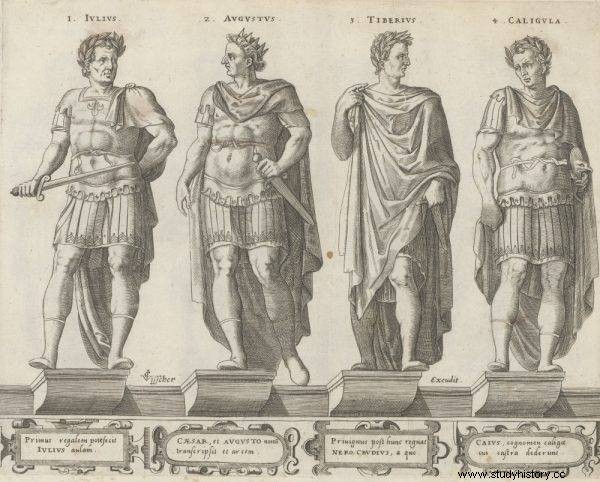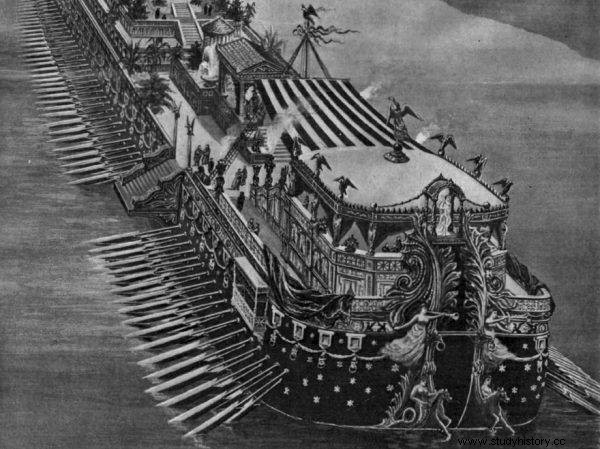Caligula is famous as a mad and extravagant tyrant. However, hardly anyone has heard of one of his biggest and weirdest frills - the floating palaces.
“He has overwhelmed all wasters with the size of profligacy. He invented a new type of bathhouse, the most bizarre types of dishes and meals. He bathed in warm and cold fragrances. He drank the most precious pearls dissolved in vinegar. He would put bread and golden snacks on the table for the guests… ”wrote the Roman historian Suetonius about the Emperor Caligula. And these were not the only luxuries of the mad ruler. He could spend a fortune with a light hand on ... ships that did not actually sail, but were huge, and perhaps overshadowed the Titanic with luxury.
The horror of life
After the tragic years of endless purges and trials for treason under Tiberius in AD 37, Rome welcomed a new emperor. Brought up among the legionnaires stationed on the Rhine, the youngest son of Germanicus, the war hero adored by the people and the army, seemed to be a breath of fresh air in the city on the Tiber. Gaius Caesar, known as Caligula, from his childhood caligae shoes, met in Rome with an almost ovation reception. The new ruler was expected, above all, to ease the rule . It was supposed to be a nice change from the reign of the strict and suspicious Tiberius.

What was expected of the new ruler was, first of all, a softening of the rule. It was supposed to be a nice change from the reign of the strict and suspicious Tiberius.
These hopes, it seemed, were not in vain. After all, Caligula suffered the horror of life. His mother Agrippina, accused of conspiracy against the emperor and of seeking the throne of one of her older sons, was expelled from Rome. In exile, she starved to death despite Tiberius' order to be force-fed. A similar fate befell those sons too. Ill in his distrust of all of them, Tiberius starved one of them and killed the other. Caligula was saved by his young age. However, although he was considered harmless, he nevertheless lived his life as a prisoner on the island of Capri under the watchful eye of Tiberius who settled there permanently.
Great hopes
At first, everything indicated that Caligula would meet the expectations of the people and the senate. Having won the coveted throne, he set about repairing the country with great enthusiasm. He abolished, among others a sales tax, and government accounts were made public again. He paid the Praetorians the rewards due twice as much as the sums promised by the every penny of his predecessor. He ordered all political trials to be discontinued, and allowed those sentenced to exile to return to Rome . He also burned the trial files of his mother and brothers, leading to their rehabilitation. Moreover, he won the hearts of commoners by organizing great circus performances.
Everything seemed to be getting better, when suddenly, after several months of rule, Caligula fell into a mysterious disease. It was not fatal. However, with how much she changed Caligula, probably many would prefer her to turn out to be so.
Crazy or angry?
Soon the senators regretted their choice as the young emperor began to show symptoms of madness . Whether it was epilepsy or Caligula's deliberate actions is unknown. After all, after regaining health (?) the former favorite of the Romans turned into a tyrant possessed with mania for grandeur . His efforts to confer consular dignity on his own Incitatus steed or his efforts to deify himself pale in the face of excesses of a greater caliber. He restored the hated trials for treason, but even without them he was able to sentence completely innocent people to death. And when it came to the execution, he did not allow a quick execution. He repeated as a mantra to his henchmen:"Hit so that the condemned man feels that he is dying" - we read in Suetonius.

He did not stop at killing. The Roman historian states that Caligula "had physical intercourse with all his sisters".
He did not stop at killing. The Roman historian states that Caligula "had physical intercourse with all his sisters" . What's more, he also did not give almost any woman of an excellent family, including married ones - and with the knowledge of their spouses. And male company was no stranger to him.
In his madness, he also did not neglect foreign policy, organizing two military expeditions at great cost. The first, to Germania, actually ended with the crossing of the Rhine, which the emperor considered a great success. On the other hand, the second one, which was an attempt to conquer the British Isles, got stuck on the beaches of the English Channel. The only trophy from this expedition was the surrender of the British prince who had escaped from the islands and a large number of shells collected at the emperor's order. He called them "the spoils of the ocean, owed to the Capitoline and the Palatine," wrote Suetonius. Then he instructed the tax officials to "prepare for him a triumph for as little sum as possible, but one that was not possible for the other, because they have the right to dispose of the property of every citizen" - we read further in the Roman historian.
Vault with ... bottom
Caligula's lost way of life soon made the treasury of Rome emptied. The denarii, which were saved by the pain-free Tiberius, were diminishing at an alarming pace, and the new ones did not want to come. In this situation, the emperor introduced new taxes, often without making them public. And when that was not enough, he did not shy away from confiscating the estates of the wealthiest Roman families under any pretext. All this to be able to continue to realize my utopian visions, such as:building mountains on the plains, leveling hills and mountain slopes and building there in places where they were not needed at all.
Construction ideas for quick liquidation of cash seemed to occupy the mind of the young emperor in particular. He ordered the construction of a long bridge connecting the Palatine Hill with the Capitol. All this to be able to efficiently get to the temple of Jupiter, which, moreover, was to persuade Caligula to live together (!). Another time, under an unspecified pretext, he requested the creation of a floating and approx. 3 km long bridge across the bay near today's Naples. The fact that the implementation of this crazy idea probably took 2,000. merchant ships, contributing to the reduction of grain transportation and, as a result, famine in Rome , of course, made no impression on the emperor. For Caligula, the only thing that mattered was the possibility of a ride on the longest bridge in the world at that time.
Ships of love
However, it did not end with unnecessary bridges. Hungry for greatness, the emperor decided that his majesty needed… floating palaces. It is difficult not to call the luxurious ten-row galleys built on his orders. According to Suetonius, " They had sterns studded with precious stones, multicolored sails, extensive thermal baths, porticos, dining rooms, bushes of grapevines and fruit trees different species. Among them, feasting on a clear day, among dancing and songs, he sailed along the shores of Campania. "

The emperor, hungry for greatness, decided that his majesty needed… floating palaces.
Unfortunately, the description of the ships ends there, and they themselves (it is not known how many of them were built) were to disappear with the death of Caligula. Most likely, they were destroyed in the act of the so-called damnatio memoriae, that is, the action of erasing the hated emperor from the pages of history. But it is also suspected that the luxury cruise liners simply burned down as a result of the orgies Caligula loved so much . Nevertheless, for hundreds of years, Suetonius's message was the only evidence of their existence. It was not even seen where they were supposed to be and was soon forgotten.
Discovered and…
Only in the Middle Ages, when fishermen from Lake Nemi south of Rome began to accidentally fish for valuable artifacts there, the legend of Caligula's ships came to life. Soon was discovered lying at the bottom of the lake sacred to the ancient Romans, a gigantic wooden structure. From that moment on, various attempts were made to recover the wreck, but due to the technological imperfections of those times, it was only possible to recover individual elements of the vessel's equipment. The wreck was also quickly linked to the person of the mad emperor. After all only he could have been audacious enough to launch his floating palaces on the water dedicated to the goddess Diana , where there was an absolute ban on sailing. Moreover, the lake is so small that you can only dream of true sailing. But who could stop him from doing that.
However, it was not until the 1920s that Benito Mussolini decided to pump the water out of the lake and extract the remains of ... two ships. The remarkable operation was a success and in 1936 a museum was opened on the shores of the lake, where the units were presented.

In the 1920s, Benito Mussolini made the decision to pump the water out of the lake and extract the remains of ... two ships.
Only this confirmed Suetonius's account. And although the tooth of time bit them well, they made an amazing impression. They were monumental for those times. Each of them was over 70 m long and 25 m wide. In the huge rooms (cabins), parts decorated with bronze, marble have been preserved , mosaics and gilded copper tiles. Lead pipes were also found, including one signed with the name of the mad emperor. Elements of technologically advanced mechanisms were also discovered such as dipper and piston pumps, ball bearing platform and parts possibly underfloor heating (!). There was no such luxury even on the Titanic.
… destroyed
Unfortunately, the destruction of the monuments was brought about by World War II, when the museum burned down along with the wrecks. Only single artifacts, scattered around the world, survived. Interestingly, one of them - a fragment of a wooden floor converted into a coffee table - was found in one of the auctions of works of art in 2017.
However, there is a chance that not everything has been lost yet. For several years, Lake Nemi has been explored in search of ... a third ship, which may still be at the bottom.
Bibliography
- Cary M., Scullard H.H., History of Rome. From the earliest times to Constantine , crowd. J. Schwakopf, vol. 2, Warsaw 1992.
- Feldhaus F.M., Machines in the history of mankind from the earliest times to the Renaissance , crowd. S. Sosnowski, Warsaw 1958.
- Krawczuk A., The lineage of Roman emperors , Warsaw 2011.
- Kubiak Z., History of the Greeks and Romans , Warsaw 2003.
- Oleson J.P., Greek and Roman mechanical water-lifting devices:the history of a technology , Toronto 1984.
- Suetonius, Lives of Caesars , crowd. J. Niemirska-Pliszczyńska, vol. 2, Wrocław 2004.
